Montana - U.S. state
For other places with the same name, see Montana (disambiguation).
Montana is a state in the northwestern United States, in the Rocky Mountains region.
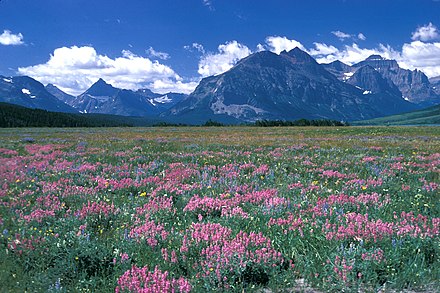 Known as Big Sky Country, Montana is a state of contrasts, from the eastern plains to the towering peaks of the Rocky Mountains in the West. Helena is the state capital of Montana, Billings is the largest city, and Missoula is the second largest city.
Known as Big Sky Country, Montana is a state of contrasts, from the eastern plains to the towering peaks of the Rocky Mountains in the West. Helena is the state capital of Montana, Billings is the largest city, and Missoula is the second largest city.
Regions
Montana is generally divided into two main regions: Eastern Montana and Western Montana. The Continental Divide of the Rocky Mountains separates the smaller western portion from the larger eastern portion. Western Montana is characterized by higher rainfall in some areas, and terrain dominated by mountains, making for picturesque scenery such as that found in Glacier National Park. Eastern Montana is flatter, with isolated "island ranges" of lower mountains intermixed with prairie and a more arid climate, balanced by the presence of several significant rivers including the Missouri River and the Yellowstone River. Some areas feature erosion-built features such as buttes and badlands.
The Montana board of tourism splits the state into 6 regions:
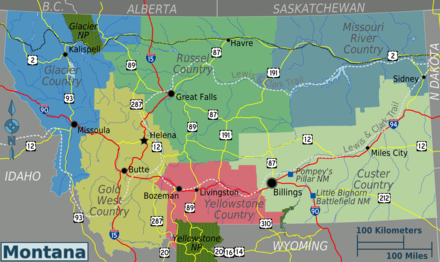
The far northwest portions of Montana, including Glacier National Park and the cities of Missoula, Whitefish, Kalispell, and Cut Bank.
Southwest Montana, including the cities of Butte and Helena.
Named for famed western artist Charles M. Russell, north central Montana including the cities of Great Falls and Lewistown.
South central Montana, the gateway to Yellowstone National Park, including the cities of Bozeman and Red Lodge.
The far northeast Montana, including Glasgow.
The far southeast Montana, including the cities of Billings, Miles City, Glendive and the Little Bighorn Battlefield National Monument.
Cities
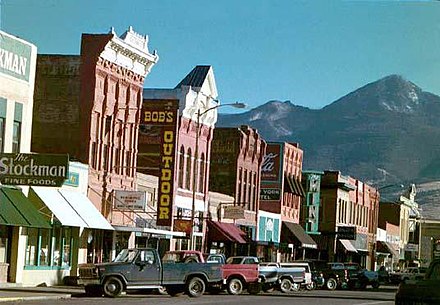
- Helena — the state capital.
- Billings — on the plains within sight of the mountains, most populated city in Montana.
- Bozeman — gateway to Yellowstone National Park.
- Butte — former mining town, once the largest city between Chicago and Seattle, famous for the Berkley Pit, the largest Superfund site in the nation.
- Great Falls — the Electric City.
- Havre — railroad town, home to many interesting historical sites including the Wahkpa Chu'gn buffalo jump, the H.Earl Clack Museum, Ft. Assiniboine, Havre Beneath the Streets, and the nearby Bear Paw Battlefield.
- Kalispell — gateway to Glacier National Park.
- Livingston — the original gateway to Yellowstone National Park. It is home to three interesting local museums and is still the Northern gateway to Yellowstone.
- Missoula — Montana's second largest city, home to the University of Montana.
Other destinations
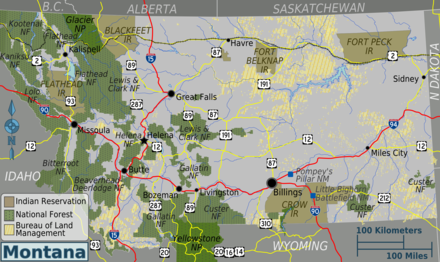
- Pompey's Pillar National Monument Large Rock where Captain Clark of Lewis and Clark signed his name (as the Expedition had split to cover more ground).
- Little Bighorn Battlefield National Monument. Custer's Last Stand battlefield and Reenactment location
- Lewis and Clark National Historic Trail - Between May 1804 and September 1806, 32 men, one woman, and a baby traveled from the plains of the Midwest to the shores of the Pacific Ocean. They called themselves the Corps of Discovery.
- Upper Missouri River Breaks National Monument is a national monument protecting the Missouri Breaks of central Montana, United States, and is managed by the Bureau of Land Management. Called "The Breaks" by locals, it is a series of badland areas characterized by rock outcroppings, steep bluffs and grassy plains along the Missouri River.
- Yellowstone National Park — Majority located within Wyoming, however three entrances to the park are located in Montana.
- Livingston — The Park County seat; at the turnoff to Yellowstone National Park.
- Gardiner — The original and only all year entrance to Yellowstone National Park.
- Cooke City — Near the Northeast entrance to Yellowstone National Park.
- Silver Gate — Near the Northeast entrance to Yellowstone National Park.
- West Yellowstone — West entrance to Yellowstone National Park.
Understand
Montana is the 4th largest state by land mass in the United States at 145,552 square miles, however the state ranks 44th in population with just under a million residents, most of whom are clustered around cities and towns. The state features wide open spaces, lonesome highways and dramatic scenery, both to the east and west of the continental divide.
Residents of Montana often classify themselves as either easterners or westerners, depending upon their geographic home. The west is often considered more picturesque, but is also more populated and heavily touristed. The eastern half of the state is more sparsely populated, with low lying plains, bluffs and cliffs. Attitude-wise, the west is generally considered more liberal, while the east, with its large ranching and agricultural operations, is considered more conservative.
The state economy is primarily based on agriculture, ranching, logging and mining as well as tourism.
Montana observes all the federal holidays, and adds Election Day (always on a Tuesday, from November 2nd to 8th). However, there may not be an election in an odd-numbered year, and local and preliminary ("primary") elections throughout the year are not holidays.
Get in
Most visitors to Montana will drive; however, the state is easily accessible by air. Some major points of entry are Billings (IATA: BIL), Missoula (IATA: MSO), Helena (IATA: HLN), Great Falls (IATA: GTF), Bozeman (IATA: BZN) and Kalispell (IATA: FCA).
A pretty popular and creative way is Amtrak's legendary Empire Builder. The train has 12 stops in Montana (from east to west: Wolf Point, Glasgow, Malta, Havre, Shelby, Cut Bank, Browning/Oct-1 through May 1, East Glacier/May 1 through Oct 1, Essex, West Glacier, Whitefish, Libby), and takes passengers to Seattle, Portland, Oregon, and Chicago from Montana's Hi-Line and Glacier National Park. Tickets should be purchased in advance, and it is generally cheaper to do so. Staffed Amtrak stations in Montana are Wolf Point, Havre, Shelby, East Glacier (when open), and Whitefish.
Major airports serve the seven largest communities, which in addition to the three cities listed in include Great Falls, Butte, Bozeman and Kalispell. Regional carriers serve some smaller communities.
Get around
Montana is a large state - a trip via interstate from the far eastern town of Wibaux to the western border town of Mullan, ID is over 700 miles (1120 km), an estimated 12-hour trip. Because residents must often drive long distances to get from one place to another, they generally love their cars - especially their SUVs and other 4-wheel drive vehicles that do well in the often hazardous winter weather. Therefore, it is necessary for visitors to consider renting a car to get around Montana as public transportation between cities & towns is limited at great distances. If a visitor cannot or will not rent a car, the following options are available:
By train
See also: Rail travel in the US
See also: Empire Builder
Amtrak's Empire Builder goes across Northern Montana stopping at Libby, Whitefish, West Glacier, Essex, East Glacier (seasonally), Browning (seasonally), Cut Bank, Shelby, Havre, Malta, Glasgow, and Wolf Point. The train continues west to Spokane and Seattle/Portland and east to St. Paul, Milwaukee, and Chicago.
By plane
See also: Air travel in the US
Daily regional flights to various locations throughout the state are provided by Great Lakes Airlines.
Service from major hubs (such as Seattle, Salt Lake City, Minneapolis/St. Paul, and Denver) continues from airports at Billings, Belgrade(Bozeman), Butte, Helena, Great Falls, Missoula, and Kalispell.
By bus
See also: Intercity buses in the US
Information on transit can be found from APTA.
- Airport Shuttle Express, +1 403 509-1570. Offers shared ride van shuttles to East/West Glacier, Whitefish, Kalispell, Glacier National Park, and most towns in northern Montana on request from the Calgary Airport. 2015-07-25
- Arrows (Express) Stage Lines (Black Hills Stage Lines), +1 402 371-3850. Goes south from Billings to Lovell, Wyoming, via Laurel and Edgar (Montana) along I-90/US-310 on one route and to Denver via Hardin, Montana; Sheridan, Montana; Buffalo, Wyoming; Casper, Wyoming; etc., along the I-90/I-25 on another. 2015-07-19
- Jefferson Lines. Travels primarily on Interstate 90 between Spokane and Billings (via Missoula, Butte, Belgrade/Bozeman and Livingston) and between Billings and Rapid City (Sheridan, Buffalo, Gillette, etc.); and on I-94 between Billings and Fargo (via Miles City, Glendive, Sidney, etc). 2015-07-19
- Salt Lake Express, +1 208 656-8824. Travels primarily on Interstate 15 from Salt Lake City through Idaho Falls to Great Falls via Dillon, Butte, Basin, Boulder, Helena, and Craig in Montana. There's also another route from Idaho Falls to West Yellowstone on US Hwy 20. 2015-07-25
By car
The easiest and most convenient way to get around Montana will probably always be by car. Destinations are spread wide even within a single city, and within cities, parking is usually ample and cheap, if not free. Rental cars are widely available, and the option to pick up in one city and drop off in another is available, though expensive.
Montana is traversed by three major interstates.
runs north-south from Alberta, Canada through Western Montana to Idaho.
runs north from Sheridan, Wyoming to near Billings then runs west through Bozeman, Butte, and Missoula to Idaho.
runs from the North Dakota border west to join with I-90 just east of Billings.
A few US Highways provide mainline travel through interesting areas of the state.
The Hi-Line, a fabled highway running through northern Montana from the North Dakota border near Bainville to the Idaho border near Troy for 666 miles. The highway runs through the plains and prairies east of the continental divide, through the Fort Peck Indian Reservation town of Wolf Point, through Glasgow, Malta, Havre, Shelby and Cut Bank until crossing the continental divide, running the south side of Glacier National Park to Kalispell, Libby and the border.
runs a meandering east to west route from Lolo Pass to the North Dakota border near Baker, through heavily forested, winding roads in the West to the dramatic flats and plains to the East. The highway runs a meandering route from Lolo Pass to Missoula, overlaps with I-90 until Garrison, continues on to Helena, then proceeds for almost 250 miles until merging with I-94 through Miles City, then continues on to the North Dakota border near the southern edge of the state.
See

Wildlife include deer, elk, moose, buffalo, big horn sheep, mountain goats, bears (black and grizzly), coyotes, wolves (mostly in Yellowstone), mountain lions, and bald eagles and other birds of prey.
Do
Montana has a recreational opportunity for every adventure seeker, every season, and every mode of transit -- by land, by boat, by bike or all terrain vehicle, there's something to keep you occupied in Montana.
Watersports
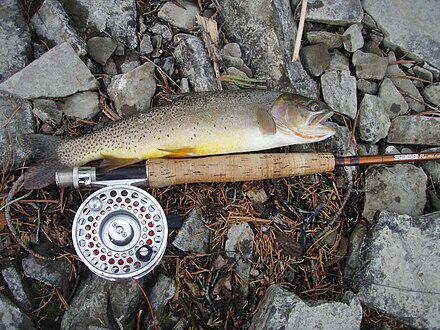
- Whitewater Rafting - many Montana rivers, especially in the western part of the state, offer world class rapids. Many companies offer float trips of varying degrees of difficulty and length. Rafting on your own is greatly discouraged due to the extreme danger often found in mountain rivers.
- Boating - bring your powerboat, canoe, kayak or schooner and find a lake, river or stream to wile away the day. Kayak and canoe rentals are widely available.
- Floating - a unique Montana experience. Rent inner tubes, take a cooler of beer and float a river with a few, or a bunch, of your closest friends on a hot day. Pick a river that's wide and slow, or fast with rapids, and enjoy the view from a cool Montana waterway.
- Fly fishing - iconically Montana due to the movie A River Runs Through It, which was filmed along parts of the Blackfoot river in Western Montana, anglers flock to rivers in the late spring and summer months to catch the "big one". Outfitters available for guided trips, or to rent you the gear you'll need. Ask a local for a good spot.
Mountain pursuits
- Hiking/Backpacking
- Mountain biking
- Climbing
- Off road vehicles
- Horseback riding
- Billings Horseback Rides (dead link: March 2023)
- Wagon Train Adventures
- Happy Pappy's Holdup
- Whoopah Ride (dead link: January 2023)
Winter sports
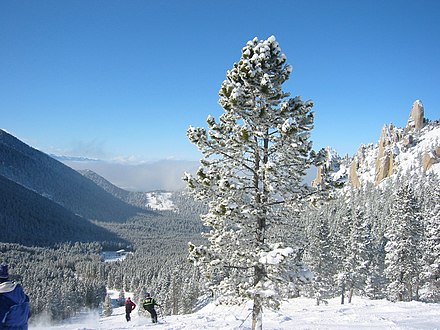
- Skiing/snowboarding. Montana has two large resort ski areas, Big Sky and Big Mountain, as well as smaller local hills. Check individual websites for current conditions and pricing. The mountains usually open around mid-late December and remain open into April, sometimes May. There are also options for backcountry and heli-skiing.
- Bear Paw
- Big Mountain
- Big Sky - This is a large resort area located 45 minutes south of Bozeman. This has two mountains, lots of lifts, including "The Tram," a gondola to the top of Lone Peak. Pick a clear day for an unparalleled view of the Spanish Peaks and incredible expert skiing. Winter and summer resort activities available.
- Blacktail Mountain
- Bridger Bowl - 20 minutes north of Bozeman, this is a locals' mountain with 7 lifts. Most of the mountain is intermediate level and above, including "The Ridge," a hikeable area to the top of the mountain and accessing a wide variety of expert terrain.
- Discovery Basin
- Great Divide
- Lookout Pass
- Lost Trail Powder Mountain
- Maverick Mountain
- Montana Snowbowl - Located 20 minutes from Missoula.
- Moonlight Basin
- Red Lodge Mountain Resort
- Showdown, Teton Pass
- Turner Mountain
- Yellowstone Club - A private ski and golf community located next to Big Sky.
- Snowmobiling
- Snowshoeing
- Cross Country Skiing / Nordic Skiing
Skateboarding
Montana is now home to some of the best skateparks in the country with some pretty unique features. For directions, descriptions and more information visit Skate Montana (dead link: June 2020)
- Dave Olseth Memorial Skatepark. Whitefish.
- Woodland Skatepark, Kalispell - Built by Dreamland
- 7th and 7th Skatepark, Polson - Featuring the Helmet, Built by Dreamland
- MOBASH Skatepark. Missoula - Lit at night and featuring a cradle, Built by Grindline.
- Anaconda Skatepark - Built by Dreamland
- Dillon Skatepark - The Race Track, Built by Grindline
- Butte Skatepark - Built by Dreamland
- Riverside Railyard Skatepark, Great Falls - Built by Grindline
- Helena Skatepark - Built by Alltec
- Bozeman Skatepark - Built by Team Pain
- Billings Skatepark
Eat
For a state generally associated with cattle chomping green grass underneath big blue skies, Montana has quite a bit to offer outside of meat and potatoes. Within cities and settled areas you should find a good variety of the ubiquitous fast food drive-thrus, homey cafes and diners, delis, steakhouses, Mexican cantinas, noodle and Asian grills and the odd Indian or Sushi restaurant.
In rural areas, however, your selection may be much more limited. Every small town will have at least one eatery, even if it's a cafe stuffed in the corner of a post office, or a burger joint in the back of the town bar. Quality will vary, of course, but the experience might stick with you. If you are looking for meat and potatoes, look no further than the local cafe, diner or steakhouse. The beef will be fresh, most often locally raised and slaughtered, and cooked however you want it — but if you say well done, your server might cry.
For local flavor and distinctly Montana eateries, try the Staggering Ox, with locations in Billings, Helena and Missoula, or MacKenzie River Pizza Co, with locations in Billings, Bozeman, Helena, Great Falls, Missoula, Kalispell, Belgrade, Whitefish and Butte. The Pickle Barrel is excellent and famous for sub sandwiches with the original location in Bozeman, other locations in Belgrade and Livingston.
Buffalo chili, cowboy beans, Indian fry-bread and steak are types of cowboy food that many love to experience while in the Big Sky Country whether in Billings, Hardin, Laurel, Red Lodge or Helena. Try some chuckwagon food in and around the state like Pappy's MT Catering and other quality businesses who cater for large groups and gatherings in Montana.
Be sure to get a scoop of Wilcoxson's ice cream. This Montana company offers traditional favorites along with specialty flavors, like Moose Tracks. Their fudge bars, available at any convenience store, are a must-have.
During the summer months, primarily late June, July and early August, look for huckleberries and famous Flathead cherries at farmers markets and roadside stands throughout Western Montana. If you're looking for adventure, ask a local for a good place to go pick your own huckleberries — but beware, they may keep it a closely guarded secret. If you go, take some bear spray, they love the treat, too.
One type of food many adventurous visitors seek is wild game. It is important to know that wild game cannot be sold legally in Montana, due to the impossibility of ensuring health and safety standards. A few restaurants offer bison and, less commonly, deer and elk; these are legally required to be animals raised on a ranch, not in the wild. Their food supply is controlled and they often taste milder than their wild counterparts (elk and bison are especially mild and very similar to beef), but retain many of the health benefits of wild meat. Few Montanans eat this meat regularly, however, and it can be challenging to find a restaurant serving it (it is also considerably more expensive than beef or pork). If you have a chance to eat wild game at a home or potluck, it is worth trying it, but, in general, it is safer to eat the meat of herbivores than carnivores.
Drink
Montanans, as a general rule, love their beer. Increasingly, Montanans love their microbrews, especially those brewed locally. Some famous microbrews are brewed in Montana, including Moose Drool, a brown ale brewed by Big Sky Brewing Co. and the best selling microbrew outside and inside of the state. Microwbreweries in Missoula, Kalispell, Helena, Billings and other cities and towns allow for cheap tasting and filling of a growler — usually the best bang (or buzz) for your buck. A list of breweries can be found at VisitMT. In 2012 Montana had 18.2 craft breweries per 500,000 people making it the 3rd most micro-breweries per capita in the country.
Outside of microbrews, domestic favorites vary from Coors to Budweiser, with light varieties in between. Bars good for bar hopping can be found in the downtown districts of most cities, especially Missoula, Billings and Bozeman, and they're generally a good gauge of local color and culture. Outside of large cities, most small towns have at least one bar, and they often serve food of varying quality. A general rule of thumb — if the town has a post office (the Montanan's definition of a town in rural areas) then there should be a bar in which you can quench your thirst.
Sleep
Montana is a great place for camping, there are plenty of camp sites in the state. Prices are reasonable, but the sites are often rather spartan. Sites generally accommodate both tents and RVs.
Stay safe
Montana is safer than most when it comes to violent and personal crime, but the state still suffers from one of the highest highway and road death rates in the country. Long-distance travel over great amounts of time resulting in fatigue, hazardous winter road conditions, distances from emergency services, and alcohol consumption frequently contribute to the high number of deaths on Montana's highways yearly. This is not to say it's unsafe to drive in Montana — just beware. If you are unused to driving winding mountain roads or driving in extremely hazardous snow/wind/ice/rain/sleet conditions, do not do so. Wait for the weather to clear — it may result in a good story, those 12 hours you spent at a truck stop with some friends waiting for a pass to clear.
If you do find yourself stranded in winter conditions, it's important to remember two things — first, be prepared. Always carry water, snack foods, a small first aid kit including a space blanket and a cell phone, if possible, for emergencies. Although there is cellphone coverage along most of the highways, it can be unreliable in places, especially the numerous mountain passes. Many rural roads have no cellphone coverage, so don't rely on always having quick emergency communication. Second, if you become stranded, stay in your car, turn on your hazard lights, and wait for help.
There is a lot of wildlife around the state, including deer, elk, moose, bears, buffalo, and coyotes. Always remember that these are wild, and do not tolerate people with cameras getting close, much less trying to put their kid on the buffalo. Most animals will avoid humans by our scent or noise, although beware of deer along the roads. When camping, always keep food in your car, or hung from a tall tree. Tents are like tissue paper to a hungry bear.
More often than not, Western Montana will be hit by major forest fires toward the middle and end of summer. While it's very unlikely you will be directly in the path of one, they can significantly degrade the air quality. If one is headed toward you and you are ordered to evacuate, do it.
Outside of environmental and road hazards, use common sense, and you should be fine.
Respect
Montanans treasure their state, loving it for the recreational opportunities, wide open spaces, and the friendly nature of their neighbors. They, in general, welcome tourists and travelers, and will be glad to let you in on cool places to go, the best hike to take, or their favorite fishing hole. However, in South-Western Montana, people tend to be slightly less tolerant of tourists, being very protective of their land. In addition, some Montanans are very proud of being 'rednecks,' and may be seen sporting 'redneck proud' T-Shirts, caps, or bumper stickers. This is not meant to be derogatory in any way, but is an expression of pride in Montana's rough and wild cultural heritage.
Any disrespect of land and nature will not be tolerated. When enjoying everything Montana has to offer, please respect the lands, waterways and wildlife by following common sense. Don't litter, pollute or otherwise upset the landscape any more than you must, and though it is a cliche, do not feed the wildlife. In general follow the principles of Leave no trace camping and you should be fine.
Go next
Montana is the only state that borders more than two Canadian provinces. However, access to British Columbia is somewhat limited.
- North Dakota - Montana's northeastern neighbor is America's least visited state, but its isolation provides opportunities for uncrowded visits to the state's hills and lakes, badlands, plains, and old frontier forts.
- South Dakota - Home to such natural and cultural wonders as Badlands National Park, Wind Cave National Park and Mount Rushmore, Montana's southeastern neighbor offers a surprising amount for travelers to see and do.
- Wyoming - Most of Yellowstone National Park is in Montana's southern neighbor, so you'll obviously not just want to visit the small section that's in Montana. Note that Montana is not only on the north side of Yellowstone, but to the west also. West Yellowstone, Montana is one of the major entrances to the park, and the Wyoming border is just two and a half miles away.
- Idaho - Montana's western neighbor is a rugged state, with snow-capped mountains, whitewater rivers, forests, high desert, and plenty of wilderness.
- British Columbia - Crossing the state's northwestern border (US Hwy 93 via Kalispell) into Canada leads into the mountainous terrain of southeastern British Columbia.
- Alberta - This Canadian province is located to the north of Montana and offers everything from the beauty of the Rockies to the serene flatness of prairie to the wilderness of the northern forests.
- Saskatchewan - Located to the northeast of Montana, the southern portion of Saskatchewan is predominantly prairie (with a reputation for being very flat) known for its seemingly endless fields of wheat.
Montana
mt.govUnited States
usa.govPopulation:327.2 MDial code:+1Currency:Dollar (USD)Voltage:120 V, 240 V, 60 HzNEMA 14-30NEMA 14-50